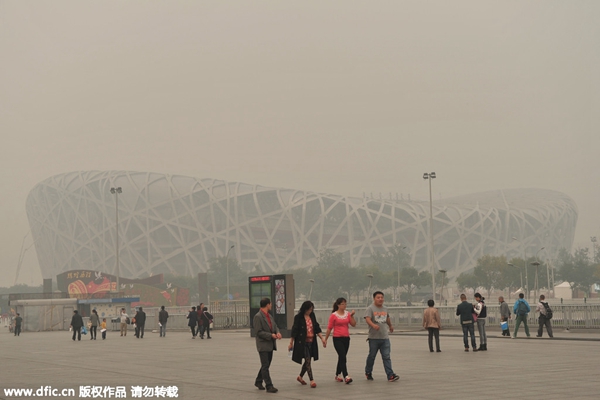 |
|
The "Bird's Nest" National Stadium can hardly be seen in severe smog in Beijing on Dec 1, 2015. [Photo/IC] |
Emissions of PM2.5 should be cut by about half on average across China if air quality in most cities is to reach the national standard by 2030, said an official from China's top environmental planning institution at a clean air forum in Beijing on Saturday.
According to the national standard, the concentration of PM2.5 - particulate matter with diameter of less than 2.5 microns that can penetrate the lungs and harm health - should be below 35 micrograms per cubic meter.
Other major air pollutants also need to be reduced drastically, with SO2 dropping by 40 percent, NOX by 45 percent and NH3 by 34 percent, said Wang Jinnan, Vice President of Chinese Academy for Environmental Planning.
More than 300 officials, experts and professionals from central and local governmental institutions, industry associations, universities, international organizations and companies attended the first Bluetech International Clean Air Technology Forum held by Clean Air Alliance of China (CAAC) amid worsening air pollution in China.
They shared ideas on how to combat smog, while some companies were rewarded for developing advanced technologies to improve air quality.
China is expected to take three steps to make air quality in most of the 338 prefecture level cities or above meet the national standard by 2030, said Wang. The first step is to realize a target set in the Airborne Pollution Prevention and Control Action Plan (2013-17) unveiled in September, 2014, which aims to decrease the concentration levels of particulate matter by at least 10 percent by 2017 from the levels in 2012 for the nation's 338 cities.
The other two steps require southern China's Pearl River Delta region to meet the national standard by 2020, followed by eastern China's Yangtze River Delta region and most seriously, northern China's Beijing-Tianjin-Hebei (Jingjinji) region should meet the standard by 2030.
China must take extremely strict emission control measures to realize the three-step plan, said Hao Jiming, an academic at the Chinese Academy of Engineering and a professor at Tsinghua University's School of Environment, at the forum.
The measures include increasing the proportion of the clean energy use, enhancing the efficiency of coal use, reducing vehicle exhausts and Volatile Organic Compounds (VOCs) emissions, and controlling urban population size, said Hao.
China is not alone in treating air pollution. About a half century ago, The local government and residents in Los Angeles, California, the US, also struggled in combating photochemical smog and accumulated many air pollution management experiences.
